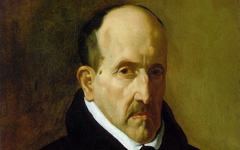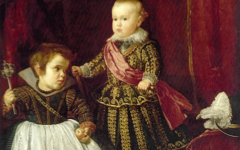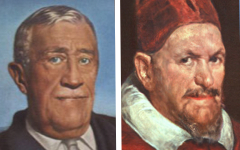Velazquez’ King Philip IV in the Frick Collection (1644)

Velazquez, Portrait of King Philip IV of Spain (1644) Oil on canvas. Frick Collection, New York.
Click image to enlarge.
The newly-cleaned Portrait of Philip IV of Spain by Velazquez in The Frick Collection is now being shown (Oct. 2010) in a one-painting exhibition accompanied by "a major discovery". That is a new explanation of the historical circumstances surrounding its commission which, in turn, is said to explain the painting. At least, that's the curators' view. But, is this portrait a historical document or a work of fiction? Compare the king’s face to that in the “newly-discovered” self-portrait of Velazquez at the Metropolitan Museum, a few blocks up Fifth Avenue, and pictorial truth seems unlikely.
Click next thumbnail to continue

L: Detail of Philip IV
R: Detail of Velazquez, Self-Portrait (inverted and rotated)
Click image to enlarge.
Their mustaches, a matter of fashion, are naturally similar but so are their eyes on the near side. Both their near-eyebrows and eyelids slope down in marked contrast to their other eye which remains level. Not only is it virtually impossible that both men shared this feature but their lower lips are also oddly similar. The king’s veers towards the far side while Velazquez’s with a highlight on the edge may or may not do the same: a possibility that the artist simultaneously creates and makes uncertain by adding that spot of light.
Click next thumbnail to continue
Now let’s look at Velazquez’s self-portrait in Las Meninas. A lazy eyelid slopes down to one side while his lower lip, off-center, veers towards the other. This seems compelling evidence that Velazquez has given the king at least two of his own features, thereby following the artistic tradition in which great masters, poets all, turn their kings' portraits into a symbol of their own majesty, the supreme all-powerful painter in their mind. By dressing the king in military outfit, even if required to do so by the commission, Velazquez indicates the struggle and bravery of a great master.
See conclusion below
The discovery that this portrait, and many others, are not accurate likenesses but self-representations of the artist is not the end of the matter, nor even the beginning of the end. It merely opens viewer's eyes to another form of visual perception, the underlying one with which this painting was created. In painting poetry like this, artists maintained their independence from demanding patrons while veiling their poetry in a web of illusions. What meanings will eventually emerge remain to be seen but until experts stop treating art like illustration, art history will make little progress.
More Works by Velazquez
The magic of visual illusion was not an invention of the Surrealists; it has been an integral part of art for centuries.

Velazquez’s Portrait of Luis de Góngora (1622)...and Picasso’s.
Notes:
Original Publication Date on EPPH: 29 Oct 2010. | Updated: 0. © Simon Abrahams. Articles on this site are the copyright of Simon Abrahams. To use copyrighted material in print or other media for purposes beyond 'fair use', you must obtain permission from the copyright owner. Websites may link to this page without permission (please do) but may not reproduce the material on their own site without crediting Simon Abrahams and EPPH.



